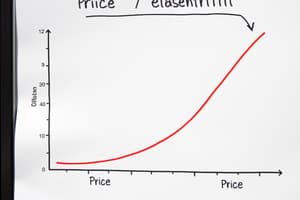Podcast
Questions and Answers
How is the unit margin percentage calculated?
How is the unit margin percentage calculated?
- (Selling price per unit + Cost per unit) X 100 / Selling price per unit
- (Selling price per unit – Cost per unit) X 100 / Selling price per unit (correct)
- (Cost per unit – Selling price per unit) X 100 / Selling price per unit
- (Selling price per unit – Cost per unit) X 100 / Cost per unit
What does price elasticity of demand measure?
What does price elasticity of demand measure?
- The fixed costs associated with production
- The total costs involved in marketing
- The total revenue generated from sales
- The responsiveness of demand to changes in prices (correct)
Which formula correctly calculates breakeven volume?
Which formula correctly calculates breakeven volume?
- Total costs / Contribution margin per unit
- Total fixed costs / Contribution margin per unit (correct)
- Total revenue / Total costs
- Total fixed costs / Selling price per unit
Typically, how is the elasticity coefficient represented?
Typically, how is the elasticity coefficient represented?
Which of the following is NOT a method to assess breakeven?
Which of the following is NOT a method to assess breakeven?
What is a key performance indicator (KPI)?
What is a key performance indicator (KPI)?
In price elasticity, what does a positive elasticity coefficient suggest?
In price elasticity, what does a positive elasticity coefficient suggest?
How is markup percentage calculated?
How is markup percentage calculated?
What does Customer Lifetime Value (CLV) primarily measure?
What does Customer Lifetime Value (CLV) primarily measure?
Which formula correctly calculates Customer Lifetime Value (CLV)?
Which formula correctly calculates Customer Lifetime Value (CLV)?
What factors are included in the calculation of CLV?
What factors are included in the calculation of CLV?
Why is estimating Customer Lifetime Value (CLV) important?
Why is estimating Customer Lifetime Value (CLV) important?
Which of the following metrics is a measure of customer sentiment?
Which of the following metrics is a measure of customer sentiment?
What is a requirement for measuring brand loyalty metrics?
What is a requirement for measuring brand loyalty metrics?
Which statement about breakeven market share is true?
Which statement about breakeven market share is true?
How can customer perception metrics like brand image be assessed?
How can customer perception metrics like brand image be assessed?
Flashcards
Unit Margin
Unit Margin
The difference between selling price and cost per unit, expressed as a percentage.
Markup
Markup
The difference between selling price and cost per unit, expressed as a percentage of cost.
Price Elasticity
Price Elasticity
How responsive demand is to change in price.
Breakeven Point
Breakeven Point
Signup and view all the flashcards
Breakeven Volume
Breakeven Volume
Signup and view all the flashcards
Breakeven Revenue
Breakeven Revenue
Signup and view all the flashcards
Breakeven Market Share
Breakeven Market Share
Signup and view all the flashcards
Contribution Margin per Unit
Contribution Margin per Unit
Signup and view all the flashcards
Breakeven market share (in units)
Breakeven market share (in units)
Signup and view all the flashcards
Breakeven market share (in dollars)
Breakeven market share (in dollars)
Signup and view all the flashcards
Customer Lifetime Value (CLV)
Customer Lifetime Value (CLV)
Signup and view all the flashcards
CLV Formula Components
CLV Formula Components
Signup and view all the flashcards
Customer Sentiment Measurement
Customer Sentiment Measurement
Signup and view all the flashcards
Brand Loyalty Measurement
Brand Loyalty Measurement
Signup and view all the flashcards
Marketing Metrics
Marketing Metrics
Signup and view all the flashcards
Brand Image
Brand Image
Signup and view all the flashcards
Study Notes
Unit Margin and Price Elasticity
- Marketing metrics are used to measure business performance from a marketing perspective.
- Key Performance Indicators (KPIs) are the most widely used metrics.
- Unit margin and markup quantify the difference between selling price and cost.
- Unit margin (percentage) = [(Selling price per unit - Cost per unit) / Selling price per unit] * 100
- Markup (percentage) = [(Selling price per unit - Cost per unit) / Cost per unit] * 100
- Price elasticity of demand measures the responsiveness of demand to price changes.
- Elasticity = [((Final demand - Initial demand) / Initial demand)] / [((Final price - Initial price) / Initial price)]
- Elasticity is typically negative, as price increases usually decrease demand. It depends on the ease of finding substitutes.
Breakeven Analysis
- Breakeven point is the sales level where total revenue equals total cost.
- Breakeven analysis is used to assess business strategy in several ways including:
- Breakeven volume
- Breakeven revenue
- Breakeven market share
Customer Lifetime Value (CLV)
- CLV measures a firm's expected profit from a single customer throughout their relationship.
- CLV = Net present value of future earnings – customer acquisition cost
- CLV formula uses customer revenues, customer costs, retention rate, discount rate, and acquisition cost, over a specific period.
Measuring Customer Sentiment
- Many marketing metrics focus on non-financial factors such as perception.
- Examples include brand attitudes, brand image, and brand preference.
- Accurate measurement scales are crucial to assess differences in sentiment.
- Brand loyalty can be measured through questions like:
- Willingness to buy the brand again
- Intent to keep purchasing the brand
- Commitment to the brand
- Willingness to pay a higher price for the brand
Studying That Suits You
Use AI to generate personalized quizzes and flashcards to suit your learning preferences.




